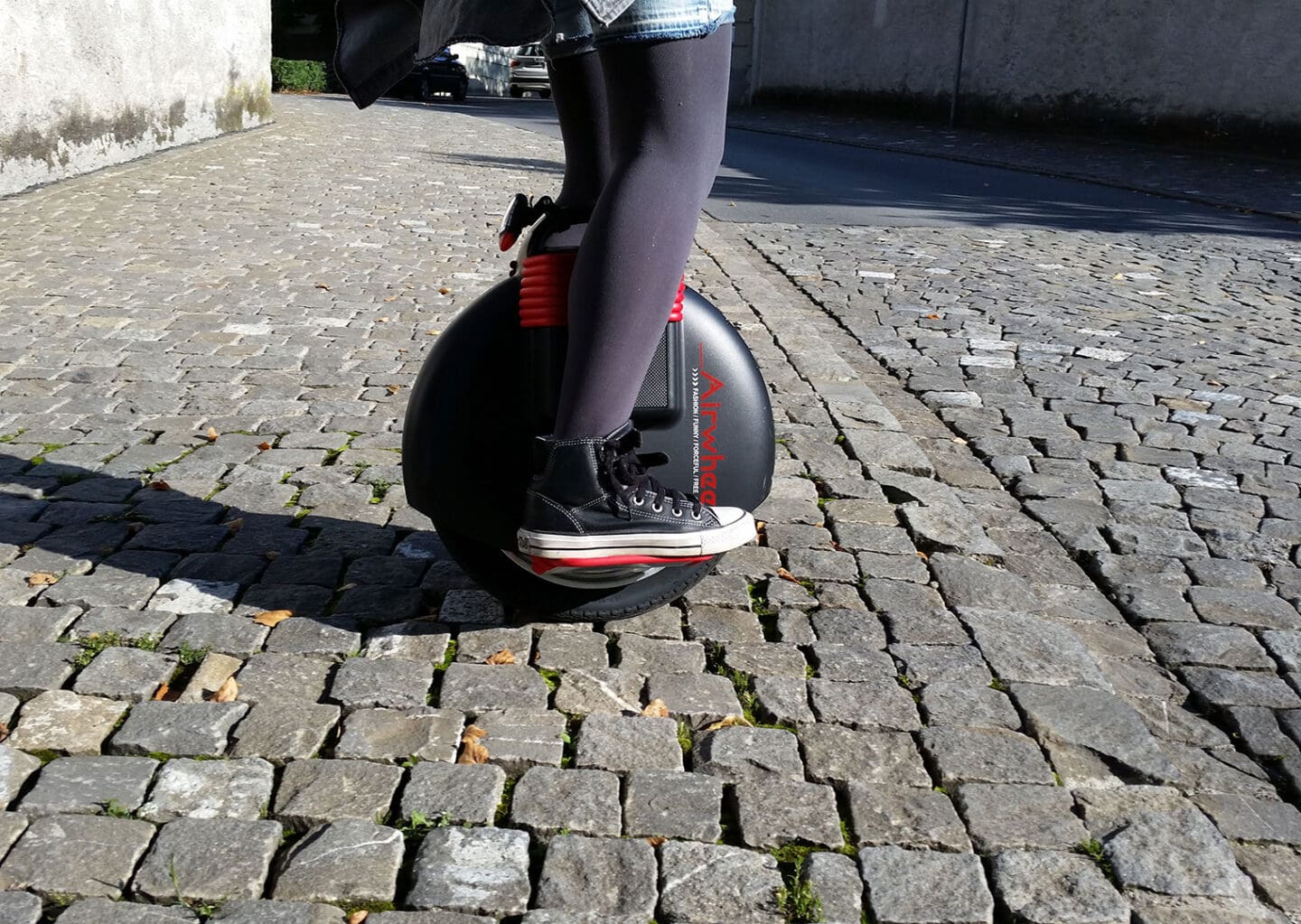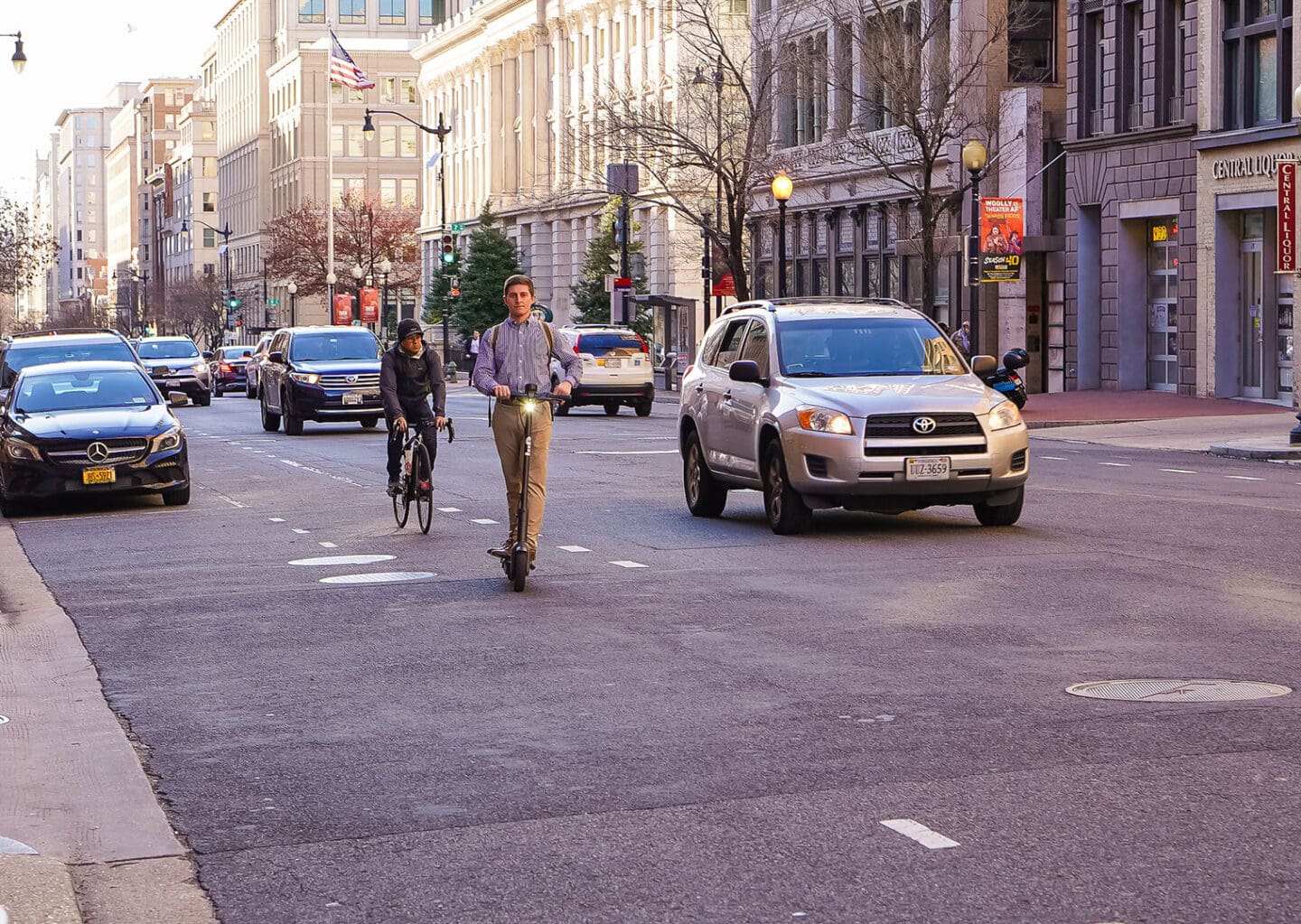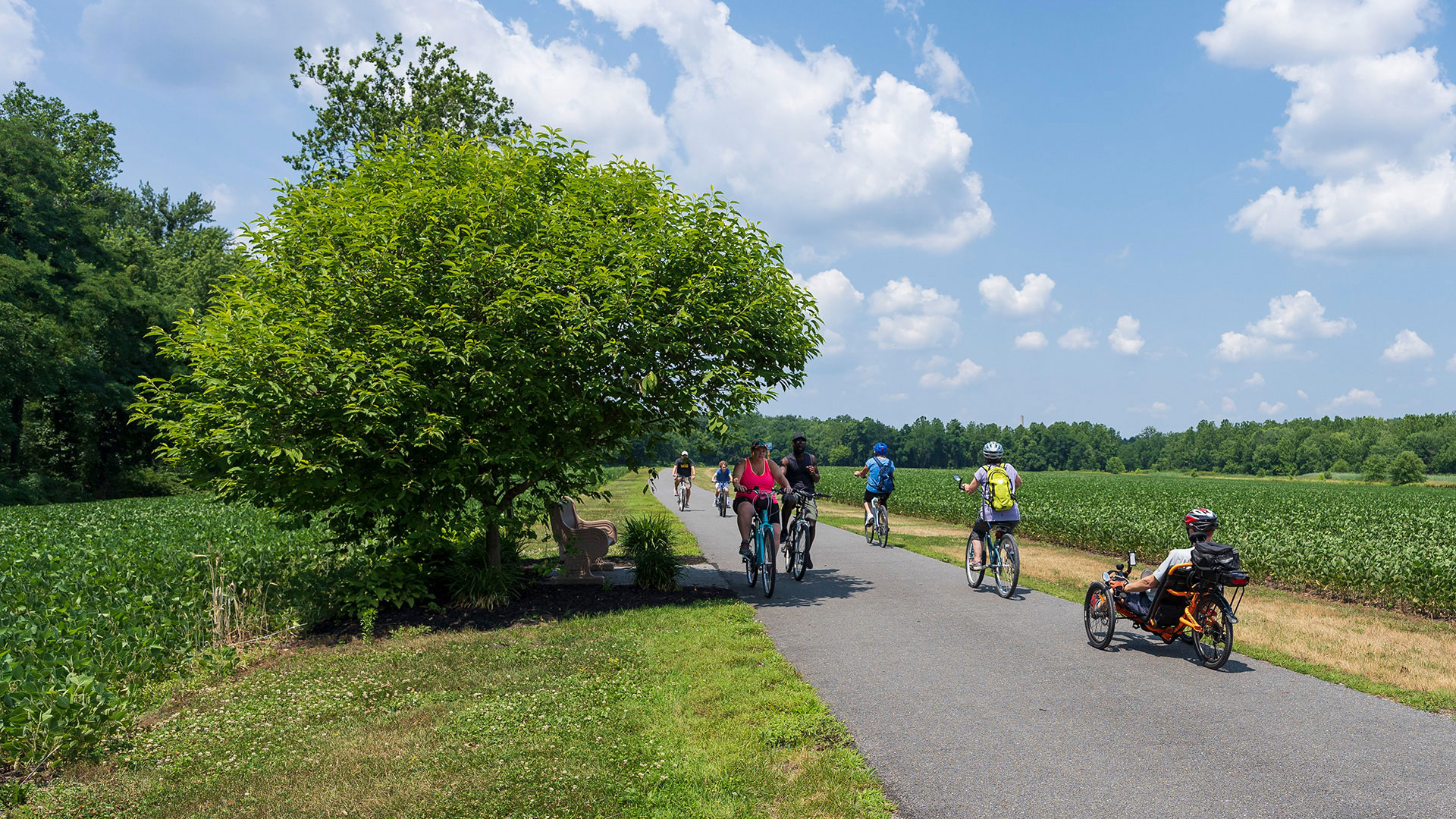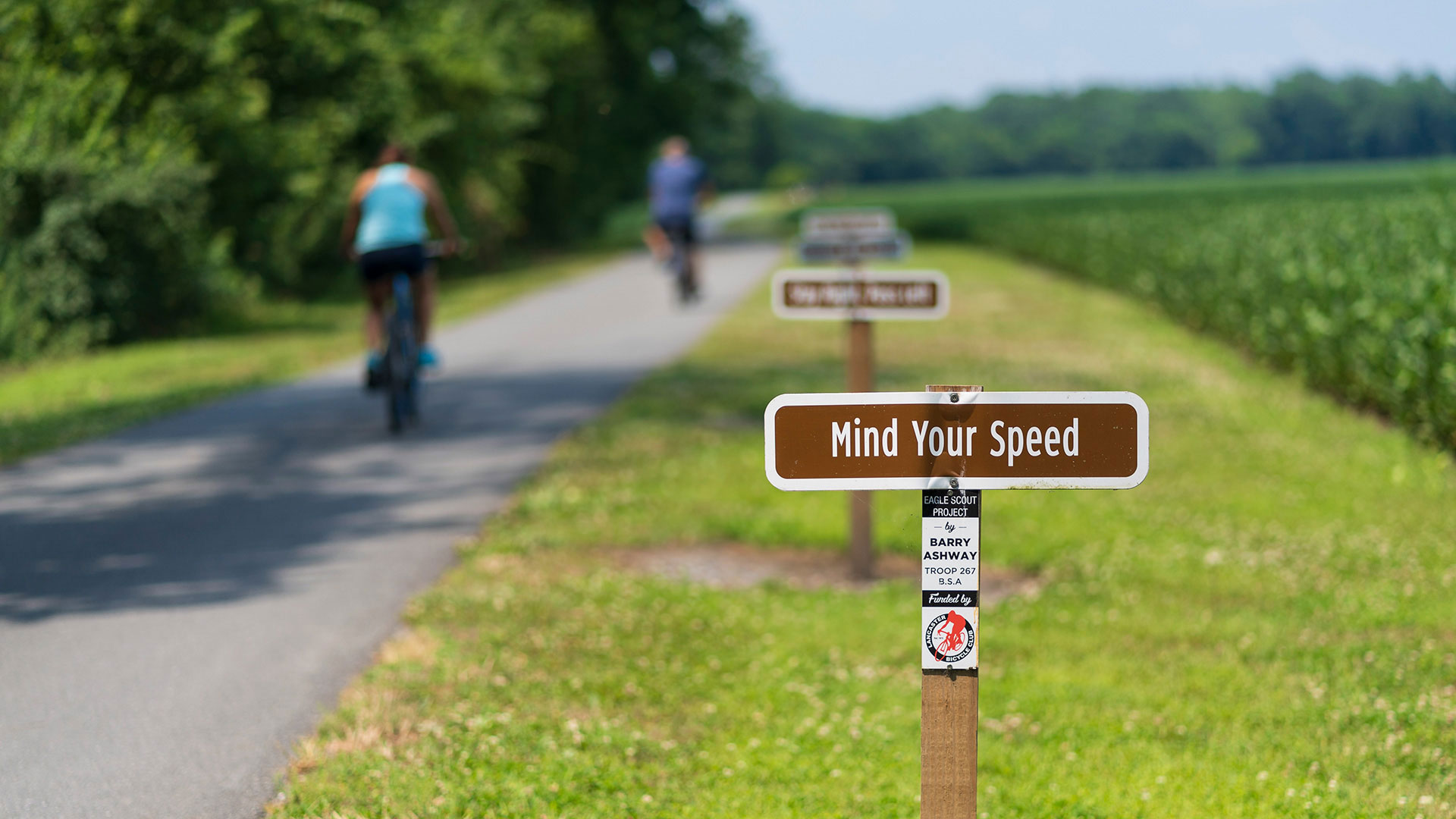October 18, 2023
Trail planning and design comes with the great opportunity and great challenge of designing for mixed modes, all ages, and all abilities. With the proliferation of new micromobility devices like e-scooters, over-wheel/one-wheel devices, and e-bikes—referred to collectively in this article as electric micromobility devices, or EMDs—both the opportunities and the challenges are heightened.
One of the biggest challenges, and the one we’re addressing in this article, is that of speed differentials. Faster-moving EMDs sharing space with slower-moving trail users can create safety challenges and make some trail users uncomfortable.

Electronic micromobility devices, like e-scooters, over-wheel/one-wheel devices, and e-bikes, bring exciting opportunities and benefits to the way communities move around.

Our charge as transportation planners and engineers is to figure out how we can maximize the exciting benefits of EMDs, while managing the risks and challenges—like that of speed differentials.
The Benefits of EMDs for Active Transportation
Let’s start with the big picture. The rise of EMDs, like e-bikes, is a positive development for active transportation—because it gets more people onto trails and into active commutes, improving sustainability, health, and livability within communities.
- EMDs make it easier to travel long distances and ride uphill, which reduces barriers to using a trail versus getting into a car.
- EMDs provide opportunities to people with physical disabilities who can’t easily ride traditional, non-motorized bikes.
- EMDs connect people to public transit options by extending the distance people are able to conveniently travel to reach transit stops.
- EMDs can be a game changer for short, quick trips, which make up a significant number of trips in urban areas. Shifting just some of these trips from car trips to EMD trips could have big climate and congestion benefits.
- For many would-be bike commuters, just getting started is the biggest barrier! Because EMDs make a ride more manageable, they can help get more active transportation users “in the door”—and that may be enough to get them hooked.
- EMDs have become a popular option for tourists, bike share systems, and rental companies because of their flexibility and ease of use for people exploring new places. In 2020, the JoyRides bikeshare system in Charlotte, NC became the first bike share system in the country to convert its entire fleet to e-bikes.
The social, environmental, and health benefits of choosing an active mode to reach your destination are well documented, so the existence of technology that reduces barriers to active transportation is unquestionably exciting.
The Challenge of Designing for E-Bikes and Other EMDs on Trails
Our charge as transportation planners and engineers is to figure out how we can maximize the exciting benefits of EMDs, while managing the risks and challenges. Perhaps the most significant challenge that EMDs pose in the planning and design of trails is that of speed differentials.
Trails are designed to accommodate a range of modes and abilities, and with this range comes differences in speeds. Historically, speed differentials were limited to differences in pedal power. This wasn’t without problems; however, those problems were relatively infrequent and trail user norms typically helped to discourage that type of behavior.
EMDs can exacerbate speed differentials, increasing the number of trail users capable of reaching higher speeds and the potential for conflicts between fast-moving bikes and slow-moving modes, like walking. And generally, formal trail design guidance has not yet caught up to take into account newer technologies, like e-bikes, that are creating greater speed differentials between users on trails.
In light of all this, what steps can we take today to help communities plan and design safe and vibrant trails?

E-bikes can exacerbate speed differentials, increasing the both number of trail users capable of reaching higher speeds and the number of potential for conflicts between fast-moving bikes and slow-moving modes, like walking.
Trail Calming: Applying Traffic Calming Principles to Trails
Helping clients plan in the midst of evolving technologies and uncertainty about the future is a challenge that energizes us. Our recipe for managing uncertainty is a close eye on trends and research, a grasp of foundational engineering and planning principles, a hearty helping of the right data, and the sauce that ties it all together: a flexible and people-first approach.
When we apply foundational engineering and planning principles to the question of e-bikes on trails, we should first ask what techniques are effectively used to manage high speeds on roadways. This question naturally leads us to traffic calming principles, which are implementing physical measures—such as medians, speed humps, roundabouts, signing & striping, curb extensions, and road diets—that are designed to influence driver behavior and slow their speed.
Traffic calming techniques can be modified and applied to trails to encourage safe speeds. This is referred to as trail calming. For an example, let’s look at the Seminole County Trails & Greenways Safety Improvement Plan.
Seminole County Trails & Greenways is one of the oldest greenway systems in Central Florida, originally built in the early 2000s. During the COVID-19 pandemic, trail usage increased by up to 50%—and it didn’t drop off, even as communities began returning to in-person activities. While this was great news for the trail system on the whole, it did mean that some situations that had previously been in the “nuisance” category were becoming real problems. One of these problems was speed differentials, both with e-bikes and high-speed road bike users, resulting in several dangerous conflicts with slower bicycle and pedestrian traffic and with motor vehicles and street crossings.
Our team was brought on to develop a plan for improving safety on this trail without dampening the community’s enthusiasm for using it. We began by benchmarking several other communities—such as Denver, Boulder, Memphis, and Orlando—that share common elements with Seminole County’s greenway system, in order to gather ideas and lessons from those communities. Then the County selected nine pilot locations and we did a field review of each to develop mitigation concepts.
We went back to proven traffic calming measures, adapting them to create a suite of trail calming options. These measures included:
- Redesigning vistas to slow speeds in locations experiencing safety issues.
- A trail mini-roundabout! In one location that has a downhill coming off a grade separation, a trail roundabout forces bicyclists to slow down.
- Separating modes in locations where there had been near misses due to having an S curve where oncoming traffic was hard to see. Bicyclists and pedestrians are delineated into two separate lanes.
- A variety of other traditional traffic calming measures, including raised crosswalks, RRFBs, pedestrian hybrid beacons, and splitter islands.
As a bonus, in addition to these trail calming features, the plan included traffic calming at interactions with traditional motor vehicles by creating a raised crossing for cars at trail crossings. Creating a raised crossing for cars and keeping the grade the same for trail users communicates a physiological hierarchy that trail users have priority.
Excitingly, Seminole County Leisure Services received nearly $7 million in funding for the implementation of trail connections and enhancements, including all nine of the pilot projects. We’ll be excited to keep you up-to-date on what we see.
Looking to the Future
As EMDs continue to grow in popularity, and we see more devices on trails capable of reaching high speeds, this should fundamentally change the way we think about trail design in the future. Here are a few additional, important considerations:
- In addition to retrofitting existing trails with trail calming and other speed management techniques, building wider trails in areas with heavy use will provide more buffer between modes of different speeds and account for different designs of EMDs. Designs should account for keeping speeds calm through wider sections of trail.
- Setting expectations for how people should behave (no matter their mode or technology) will always be paramount. Bicyclist behavior is more important than the bike they’re using. As with any roadway, adherence to proper trail etiquette (by all parties, including people walking and using slower modes) is needed to keep people safe. This can also be described as a shared set of norms on the trail and can be achieved with a multi-pronged approach, including behavior-focused signage, broader public service messaging, and the reinforcement of the day-to-day behavior of trail users.
- Finally, it’s worth noting that many states have started to adopt new e-bike classification levels, which will help us in defining more consistent regulations (and ultimately, develop more formal guidance). For example, some vehicles are not recommended for shared use paths due to their high top speeds. Having consistent classifications helps us as an industry develop consistent regulations.

Behavior-focused signage that outlines the expectations for the trail, complemented by broader public service messaging, can help develop a shared set of norms that is ultimately reinforced by the day-to-day behavior of trail users.
It’s Not About the E-Bike
While e-bikes are the top-of-mind topic when it comes to trail planning and design, they’re not the only contraptions with the potential to reach higher speeds on trails—and there just might be a new mode tomorrow that we need to plan for!
Coming back to the basics of transportation planning and design and designing facilities to manage their intended speeds allows us to create facilities, including trails, that are flexible so that we’re prepared for whatever technology comes next.
It’s important for communities to keep an open exchange of ideas and lessons learned on this topic. If you have an observation, recommendation, or insight to share, please don’t hesitate to reach out!
- Scott Curry, Associate Planner
- Wade Walker, Senior Principal Engineer
- Camilla Dartnell, Senior Engineer/Planner
